|
|

|
|
Author
|
Topic: Space Cover 144: USS Guam Recovery Force
|
stevedd841
Member Posts: 296
From: Millersville, Maryland
Registered: Jul 2004
|
 posted 01-15-2012 02:30 PM
posted 01-15-2012 02:30 PM
   
Space Cover of the Week, Week 144 (January 15, 2012)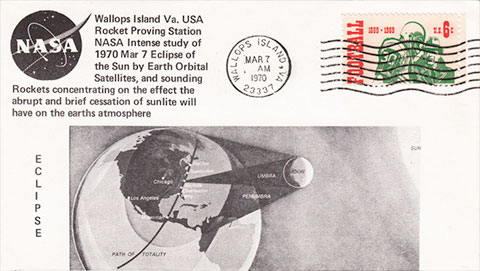 The Clyde Sarzin printed cachet cover canceled March 7, 1970, Wallops Island, Virginia, provides a visual reference to the path the total solar eclipse of the Sun would take in crossing the east coast of the United States. The total solar eclipse would directly cross NASA's Wallops Island facility, a major United States rocket range, on this date. 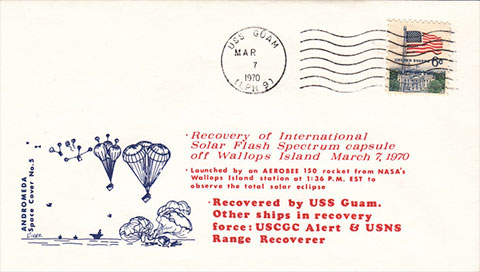 The primary recovery ship for the International Solar Flash-Spectrum Experiment was veteran U.S. Navy recovery ship, USS Guam, LPH-9. The Andromeda cacheted cover pictured is canceled on USS Guam, March 7, 1970, the recovery date of the primary space capsule and a secondary rocket test capsule involved in the experiment, both were captured by USS Guam. 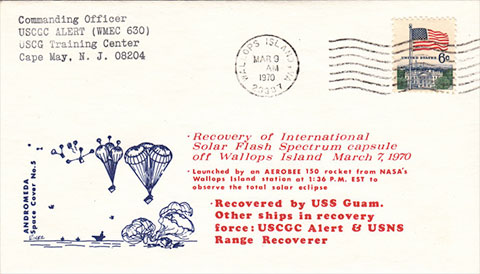 USCGC Alert, WMEC-630, was a U.S. Coast Guard medium endurance cutter assigned to the ship recovery force. An Andromeda cover for the cutter's participation and with the cutter's corner card information is canceled in the ship's homeport, March 9, 1970, Norfolk, Virginia. Launch of the sounding rockets over the Atlantic Ocean from Wallops Island necessitated recovery of the experiment's test equipment and solar flash-spectrum data in the Atlantic Ocean. 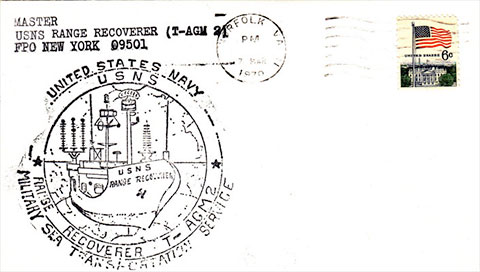 USNS Range Recoverer, T-AGM 2, a tracking ship of the U.S. Navy's Military Sea Transportation Service, is the third ship assigned to participate in the International Solar Flash-Spectrum Experiment. The ship Master's cover presented is canceled March 7, 1970, Norfolk, Virginia, the date of recovery of the primary and secondary space capsules. The cover is backstamped with the printed Andromeda cachet pictured on the USS Guam and USCGC Alert covers shown above.Space Cover #144: Unknown USS Guam Atlantic Recovery Force, 1970 Almost unknown to the general public and receiving little publicity concerning the pending total solar eclipse experiment and supporting recovery operation, a ship recovery force was at sea in the vicinity of Wallops Island, Virginia. The ships were under orders to support recovery of two major International Solar Flash-Spectrum Experiment space capsules to be launched as part of 32 sounding rockets dedicated to be launched from Wallops Island, during a total eclipse of the Sun, March 7, 1970. The three-ship recovery force included the U.S. Navy's veteran primary recovery ship USS Guam, LPH-9; U.S. Coast Guard ship, USCGC Alert, WMEC-630; and Military Sea Transportation Service tracking ship, USNS Range Recoverer, T-AGM 2. The total solar eclipse track would cross Mexico and proceed across the eastern seaboard of the United States in the early afternoon of March 7, 1970. NASA's Wallops Island missile test range was directly in the path of the total solar eclipse with the Sun crossing its meridian of longitude at 1:38 pm EST, on this date. An extremely accurate prediction of the solar eclipse resulted in an international team of scientists and astrophysicists requesting a significant experiment to study the hot upper layers of the Sun, as the Moon slowly obscured view of the Sun from Wallops Island and then a total blocking of the Sun as the eclipse progressed for three minutes and mid-day turned into night. Two rocket flight experiments for the International Solar Flash-Spectrum Experiment were approved by NASA. An Aerobee 150, and a new Aerobee 170 sounding rocket, would release space capsules after acquiring solar eclipse data from their spaceflights to approximately 142 km or 88.2 mile high altitudes and then returning back to Earth. The space capsules then would be recovered by the recovery force and returned by the task force for further analysis and study of post flight data. Harvard University Observatory, Cambridge, the United States; York University, Toronto, Canada; and the Imperial College of London, England, were directly involved in the experiment. The rocket technology and launch sequence of the experiment was directed by the sounding branch of NASA's Goddard Space Flight Center, Greenbelt, Maryland. As the International Solar Flash-Spectrum Experiment proceeded during the total solar eclipse on March 7, 1970, the experiment was successfully completed and recovery of the space capsules from the Aerobee rocket flights was made within an hour after their launch from Wallops Island during the eclipse. A post flight synopsis of test results notes that ionized gases of the outer layers of the solar atmosphere, of the chromosphere, and of the corona had been previously studied during eclipses but other ultraviolet and infrared radiation would be impossible to see, being less bright than light emitted from the Sun's solar sphere. During the solar eclipse, the extreme ultraviolet and near infrared radiation of the Sun was found to contain much more information about the chromosphere and corona as the temperature of the Sun rises from 6,000 degrees F in the photosphere to 2,000,000 degrees F in the corona. Detailed information also was obtained as the Moon crossed in front of the Sun revealing its atmosphere layer by layer and enabling its structure to be analyzed with greater depth and accuracy than had previously been feasible without occulting of the Sun by the Moon. Experimentation completed during this solar eclipse involving this group of intensive experiments in the three minutes of total eclipse also lead to a firm foundation in understanding the forces affecting the Sun and their impact on Earth. |
micropooz
Member Posts: 1568
From: Washington, DC, USA
Registered: Apr 2003
|
 posted 01-15-2012 03:59 PM
posted 01-15-2012 03:59 PM
   
Outstanding covers and story, Steve!I was on a Boy Scout campout in southeast Kansas that weekend. We watched the eclipse using the "pinhole in the end of a shoebox" viewing mode... |
Eddie Bizub
Member Posts: 100
From: Kissimmee, FL USA
Registered: Aug 2010
|
 posted 01-15-2012 04:26 PM
posted 01-15-2012 04:26 PM
   
Great covers Steve! I also have this set of covers. Any idea on quantities done? |
ea757grrl
Member Posts: 744
From: South Carolina
Registered: Jul 2006
|
 posted 01-15-2012 08:25 PM
posted 01-15-2012 08:25 PM
   
One minor correction: USS Guam was LPH-9 (LPH-7 was USS Guadalcanal). Other than that, it's fascinating, and I thank you for sharing this. In other DoD support for the March 1970 solar eclipse, an Air Force C-135 (60-0376) was outfitted as a flying observatory to follow the eclipse. Live pictures from aboard 376 were transmitted back to the networks, and correspondents George Herman (CBS) and Jules Bergman (ABC) reported from the aircraft in flight. The hour-long CBS coverage was up on YouTube a year or so back, and it's fascinating watching even if it didn't quite go as planned. |
Ross
Member Posts: 490
From: Australia
Registered: Jul 2003
|
 posted 01-16-2012 06:59 AM
posted 01-16-2012 06:59 AM
   
I agree, great covers Steve. At the same time as the experiments from Wallops Island, other countries were carrying out a co-ordinated campaign to study both the Sun as well as the Earth's atmosphere. These experiments concentrated on, amongst other things, ozone levels in the atmosphere. Australia participated in this joint effort with ozone measurements. Below is a cover from Woomera for those experiments. |
stevedd841
Member Posts: 296
From: Millersville, Maryland
Registered: Jul 2004
|
 posted 01-17-2012 06:14 PM
posted 01-17-2012 06:14 PM
   
There also is a Wallops Island, Virginia, postcard in this set issued for the total solar eclipse, March 7, 1970. Please see the Andromeda cacheted postcard below. Many thanks to Dennis, Eddie, Eastern Airlines (ea757grrl), and Ross for their additional comments. Ross, thanks for the scan of the solar eclipse cover in Australia. EA, sorry for the LPH hull number error for USS Guam. Agree, it is LPH-9 identical to the ship's cancel on the cover. Hmmm, if only I could read... Sorry for the error (and done twice!), I'll do better next time! As a former U.S. Navy guy, I should be beat about the head and shoulders for this error with poggy bait. 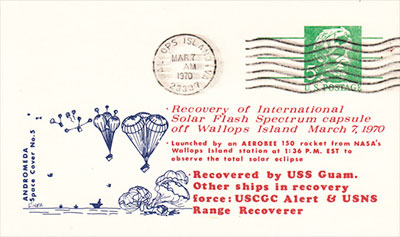 |
yeknom-ecaps
Member Posts: 697
From: Northville MI USA
Registered: Aug 2005
|
 posted 01-21-2012 01:07 PM
posted 01-21-2012 01:07 PM
   
Steve - is there anything on the back of your card?The two postcards I have are both autographed - one by the Commanding Officer of the USS Guam and the other, on the back of the card, the Executive Officer of the USCGC Alert.  |
stevedd841
Member Posts: 296
From: Millersville, Maryland
Registered: Jul 2004
|
 posted 01-24-2012 03:29 PM
posted 01-24-2012 03:29 PM
   
Tom, wow, no, my cover doesn't have the CO's and XO's signatures. Am thinking these are officers on USS Guam as they are characterized as USN written by the CO's name. Great scans, many thanks for forwarding them. I hadn't seen this on cover for this event! |
yeknom-ecaps
Member Posts: 697
From: Northville MI USA
Registered: Aug 2005
|
 posted 01-24-2012 08:41 PM
posted 01-24-2012 08:41 PM
   
Steve - per letter on Ross' recovery ship site the Executive Officer is from the USCGC Alert. | |
Contact Us | The Source for Space History & Artifacts
Copyright 2021 collectSPACE.com All rights reserved.

Ultimate Bulletin Board 5.47a
|
|

|
 advertisement advertisement

|


















